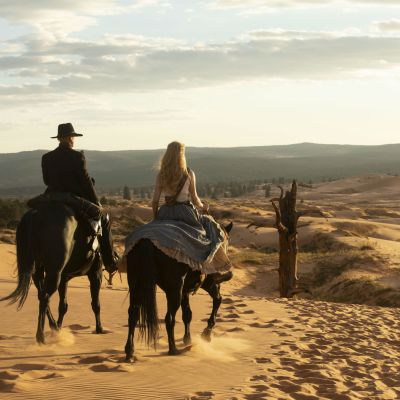A History of Sci-Fi and Western TV Crossovers
As Westworld season 3 approaches, from Doctor Who to Red Dwarf, Star Trek to Firefly, we look back at the long crossover history between the sci-fi and western genres
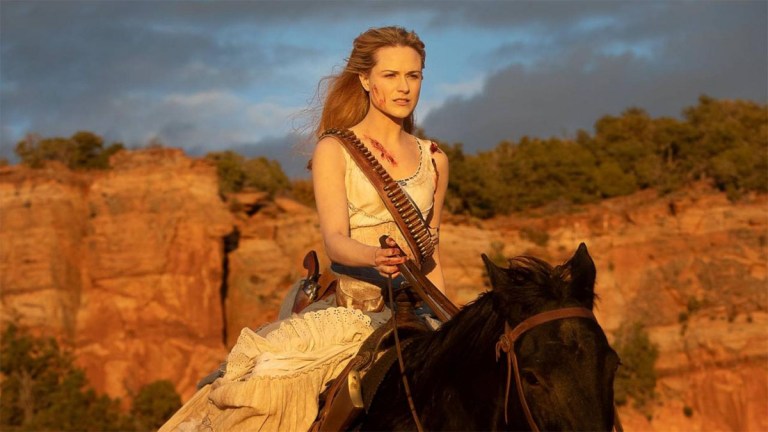
Space may be the final frontier, but the first frontier to capture the world’s imagination was the Wild West, a period in American history that held –and undoubtedly still holds – fascination for everyone from East Coast book-worms to Mongolian goat herders.
Back when NASA was in nappies and buzz was more famous as a type of saw, the brave cowboys and pioneers of the old west were the undisputed champions of popular culture. Even though the west ceased to be wild circa 1900, westerns dominated books, magazines, and screens both big and small from the 1930s right through to the early 1970s, after which the genre – give or take a few Deadwoods, Westworlds, and De Loreans – fell into decline. The moon landings, and the arrival of sci-fi behemoths like Star Trek and Star Wars served slowly to supplant the western in the public’s affections.
As the people started looking forwards, not back, it was inevitable that Buzz would beat Woody, rockets would replace railroads, and thrusters would trump Custer. But the more we looked forwards – especially into the far-off, as-yet-to-be-realised future of space wagons, ship wranglers and cosmic genocide – the more we realised that the people slinging guns and herding livestock under the endless, open skies of the prairie weren’t that different from the people mining ore on some desolate moon of Jupiter surrounded by the twinkling canvas of infinity. Frontiers were frontiers, and people were people. Plus ça change.
Science-fiction on the small screen has long plundered, parodied, absorbed and reflected the tropes and themes of the western. This is the story of the symbiosis between the genres and the eventual swallowing of one by the other, and it begins 60 or so years ago in the middle ground between light and shadow, science and superstition, and between the pit of man’s fears and the summit of his knowledge…
The Dimension of the Imagination
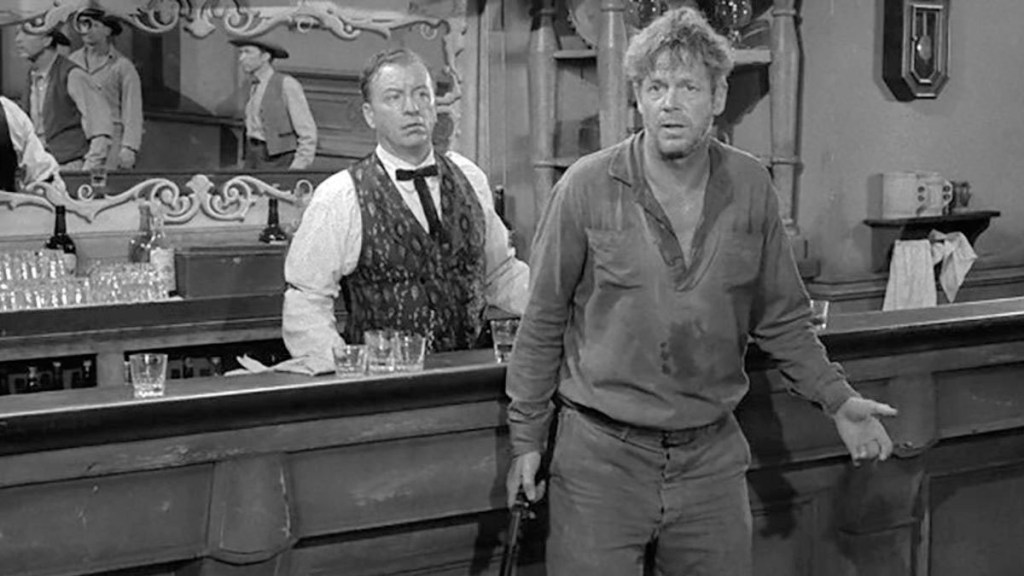
In 1959 The Twilight Zone introduced us to Al Denton, a former sharp-shooting, quick-drawing gunslinger whose guilt over his many felled opponents drove him to shaky-handed alcoholism, and a reputation as the laughing stock of his dusty desert down.
The disgraced Denton soon has a chance encounter with a mysterious salesman called Henry J Fate (famous cousin of Douglas T Blindingly-Obvious) who gives him a potion that elevates him to the status of gun-slinging superhero. The episode ends with Denton going up against an opponent who, unbeknownst to him, has also had a slug of Fate’s potion. The men – both now crack shots – shoot and cripple each other’s trigger hands, an act of fate (geddit?) that ends their duelling careers once and for all, but releases a thankful Denton from the burden of being beholden to his violent past. It’s a western with just a pinch of the other-worldly; a slight supernatural subversion of the genre’s (even by that time) most well-worn tropes.
In 1966 Doctor Who followed suit and headed west. Season three’s ‘The Gunfighters’ sees the First Doctor (William Hartnell) and his companions Steven and Dodo taking a trip in the TARDIS to Tombstone in 1881, mere days before the Gunfight at the O.K. Corral. It isn’t long before the trio are embroiled in the event, with the Doctor being mistaken for the irascible Doc Holiday, Dodo being kidnapped, and Steven having to prove his worth as a saloon-based crooner to a group of trigger-happy cowboys.
‘The Gunfighters’ is a serial that tends to split the fans: with its wilfully comedic tone, scant sci-fi trappings and the absence of any real philosophical conundrums (and the never-ending recurrence of that infernal ‘Ballad of the Last Chance Saloon’) it’s not everyone’s cup of neat whiskey. Enjoyed on its own terms, though, ‘The Gunfighters’ is a fun, tongue-in-cheek romp with plenty to offer in the way of peril and laughter. In any case, it’s hard to resist the allure of a Wild West setting, especially when it’s filtered through the eyes of the universe’s favourite space-faring grandfather.
Given Doctor Who’s longevity, and the obvious parallels between the Doctor and the trope of the nameless hero who rides into town to save the day, it’s perhaps surprising that the show has only returned to the Wild West once, in the episode ‘A Town Called Mercy’, when the Eleventh Doctor (Matt Smith) helps to defeat a gun-slinging cyborg.
Although not explicitly a western, ‘Colony in Space’, a Jon Pertwee-era adventure about natives being driven from their settlement on a far-future planet, echoes many of the genre’s core themes and tropes.
I’m Not a Number, Y’all
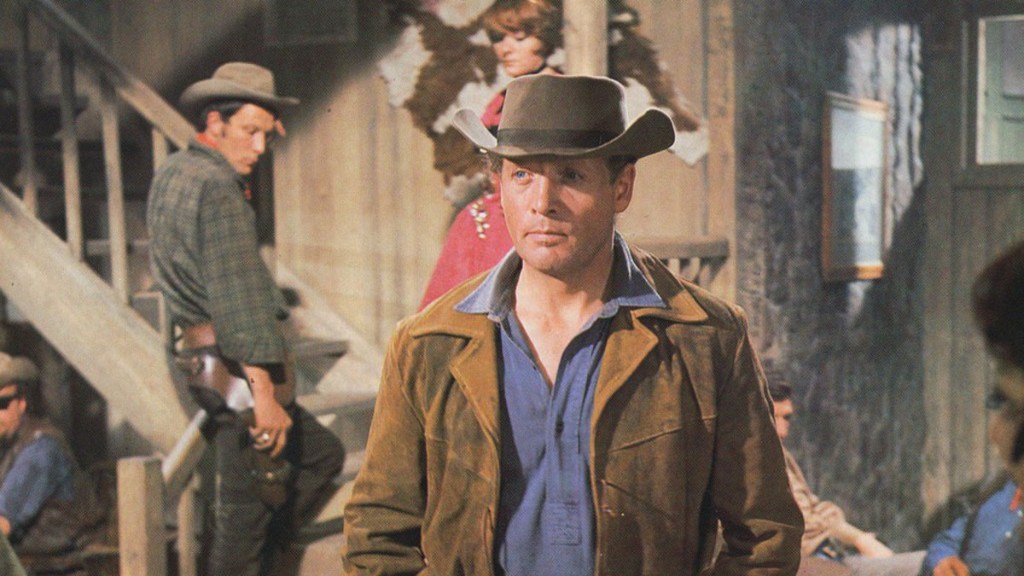
Patrick McGoohan made a career out of portraying laconic secret agents and dead-eyed villains, but he always hankered after a role in a western. Thankfully, his cult, 1960s sleeper-hit, The Prisoner – about a laconic secret agent held against his will on a mysterious island by persons and for reasons unknown – helped make Sheriff McGoohan a reality.
Originally conceived as a seven-episode story, the show’s popularity led to its run being extended, which put enormous pressure on McGoohan and the writers to come up with fresh ideas. The episode ‘Living in Harmony’, in which McGoohan’s Number Six is manipulated by his information-hungry captors into believing that he’s a Wild West sheriff, was essentially just McGoohan saying, ‘F*** it, we’ll do a western.’ While the episode is admittedly something of a filler, the mix of spy-fi and western works surprisingly well, and fits the sense of wilful weirdness for which the show continues to be famous.
Sci-fi shows would remember this lesson, and return to drink from the western well whenever they needed to bend or blend reality, or simply put their protagonists through the psychological wringer.
In 1993, UK sci-fi comedy Red Dwarf combined the washed-out, washed-up gunslinger trope with the High Noon showdown to give us the sixth season episode ‘Gunmen of the Apocalypse’, an unapologetic love-letter to the western set inside the crew’s VR game machine.
The mechanoid Kryten hides the last vestiges of his virus-stricken consciousness inside a western game, where it becomes embodied in the character of a washed-out, heavy drinking sheriff. If the crew – VR headsets duly donned – can’t help Kryten to get sober, recover his memories and find a way to fight the virus – which has manifested itself inside the simulation as the Four Horsemen of the Apocalypse, ready to run Kryten out of town – then they’re all doomed, literally, and not figuratively, because out in the real world their virus-ridden ship is on a collision course with a sun.
The episode is a delight for anyone who ever watched a western as a child and wished they could strut and swagger into some dusty, one-horse town and become its avenging angel. Before they enter the game, each of the crew has to choose a character, each with their own special powers and abilities. Watching the hitherto cowardly Rimmer triumph in a fist-fight as bare-knuckle boxer Dangerous Dan McGrew, and the fleet-footed Cat shoot bullets out of the air, all spangly and sequined as The Riviera Kid, is a genuine joy to behold, and incredibly funny to boot. Of course, Red Dwarf being Red Dwarf, it isn’t long before the crew members find themselves standing before the Four Horsemen of the Apocalypse shorn of their special powers.
A little more recently, Archer took a trip to the wild-west, during its ‘Archer in Space’ season, a nod to the now common trope of mind-bending blending between the two genres. It was, however, a fiction inside of a fiction, with both the space and western elements revealed to have been part of the wise-cracking spy’s prolonged coma dream.
Wagon Train to the Stars
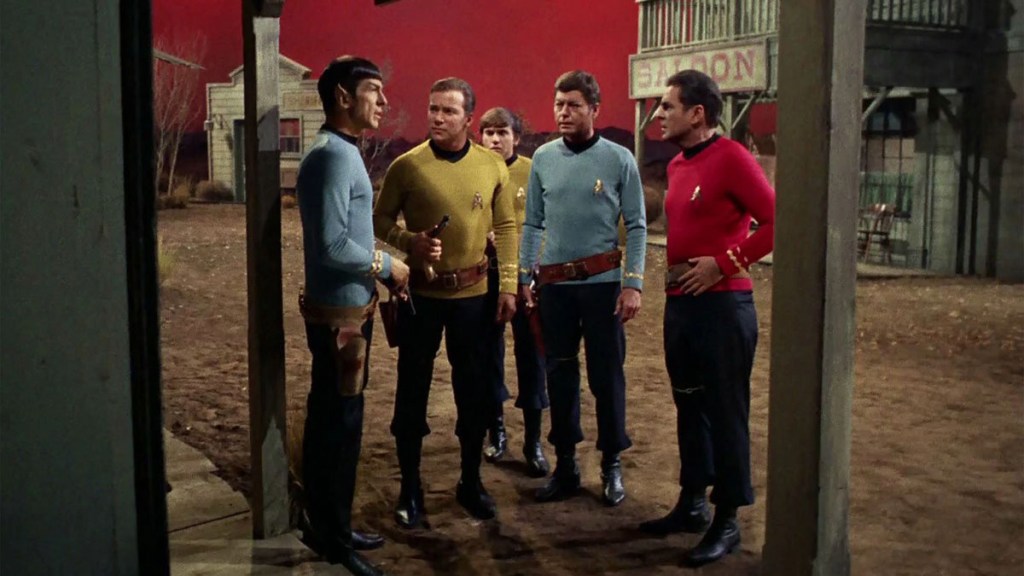
Back to the 60s again, and to Star Trek, a show that Gene Roddenberry sold to NBC executives as ‘Wagon Train to the Stars’. The necessity of this tag-line tells us everything we need to know about the heavy cultural influence of the western on Roddenberry’s outlook and output, as well as the genre’s pre-eminence in the imaginations of the TV-watching public of the time. To sell his sci-fi idea, Roddenberry first had to hitch Kirk’s interstellar wagon to a more terrestrial version.
If Star Trek was indeed a space western, then it embodied American patriotism and frontier-spirit writ large, and with little appetite for revisionism. Kirk was the gung-ho maverick who said to hell with authority, and went into most situations with his testosterone turned up to eleven, and all-phasers blazing. It never occurred to anyone – least of all Kirk – that he was anything other than the hero of the moment, no matter what he did or how he behaved. He was a strong, brave, chisel-jawed frontiersman; the sheriff, drover, pioneer, pilgrim, judge, jury and executioner all rolled into one, and woe-betide anyone who got in his way.
The third-season episode ‘Spectre of the Gun’ followed Doctor Who’s lead by placing Kirk, Spock, Bones, Scotty and Chekov in the middle of the Gunfight at the OK Corral, albeit a simulation of it on an alien planet. The Enterprise bridge crew found themselves cast as the villains for a change, forced to take on the identities of the Claytons, the band of varmints destined to die in battle against the Earps. When Kirk refuses to give in to his blood-lust following the apparent murder of Chekov, the mysterious aliens realise that humanity is worthy of preservation and friendship, and duly restore the crew’s life and freedom. It’s ironic that one of the few times Kirk doesn’t act like a Wild West gunslinger is when he actually is one.
Thanks to the holodeck, Star Trek: The Next Generation was able to roll out a western-themed episode without the need for any alien contrivance. Season six’s ‘A Fistful of Datas’ pits Worf, his son Alexander, and Troi against an ever-increasing army of deadly, fast-fingered Datas in the holographically-rendered town of Deadwood. Data’s drawling, quick-drawing likenesses get stuck in the program by accident after Geordi plugs Data’s head into the computers at engineering, which must’ve seemed like a great idea at the time.
The most obvious choice to play sheriff in this episode would’ve been Riker, with his commanding manner, charm and twinkle-eyed mischievousness (although it’s highly likely he would’ve broken the holodeck once he discovered the brothel). But the great fun of this episode is in watching the stoical and austere, fish-out-of-water Worf reacting to face-slaps from barmaids, insults from rogues, and trying to reconcile his Klingon sense of honour with the double-dealing, free-wheeling world of the old west.
If the original Star Trek series captured some of the western’s spirit, then Star Trek: Deep Space 9 (the darkest and grimiest Trek incarnation until Discovery and Picard came along with their increasingly brutal series of murders and inter-galactic F-bombs) took the wagon-wheel and ran with it. Not since the Cantina in Star Wars had the phrase ‘space western’ been a better fit. Deep Space Nine was a futuristic frontier town orbiting a frontier planet, and Commander/Captain Sisko was the wounded, widowed lawman tasked with keeping the precarious balance of peace between hostile factions, all while trying to keep his young son from being corrupted by the untamed environment around them. A constant supply of quixotic and exotic out-of-towners swarmed the station, some looking to get rich, some looking to get lost, a whole spectrum of strangers spanning the good, the bad, and the ugly, with Constable Odo and greedy bar-keep Quark tussling for their souls either end of the promenade.
The world of Deep Space 9 was painted in shades of grey. It was just as likely that the Constable or the Commander would surrender to their basest instincts, as Quark – the Al-Swearengen of Ferenginar – would shock his peers and persecutors with an act of genuine selflessness.
No wagons or wheels featured in this western. The station’s crew couldn’t just trundle off into space at the end of an adventure. They had to deal with the consequences of their actions, and find a way to exist in the murk and squalor of frontier life. As the western itself went through a revisionist period, as too did the space western. Deep Space Nine wasn’t interested in lionising its sheriffs or sugar-coating its influences, and used its western-pedigree to explore themes like the impact of colonisation, and the enslavement and displacement of indigenous peoples, the reality of racism and territorial aggression. Kirk’s way just wouldn’t cut it any more.
This revisionist spirit continued into Joss Whedon’s short-lived cult favourite Firefly, which saw spaceships sharing the screen with horses, and frontier mining towns mired in moral ambiguity. Last year, The Expanse, in its new home at Amazon, delivered a tense, trauma-filled exploration of new worlds and the new political paradigm ushered in by the ring gates that wore its western themes firmly on its sleeve. Late last year, The Mandalorian arrived with the story of another space-age bounty hunter. And now Westworld is back, the show that cast all of its human characters as cowboys, of one stripe or another, and made villains of them all.
Coda
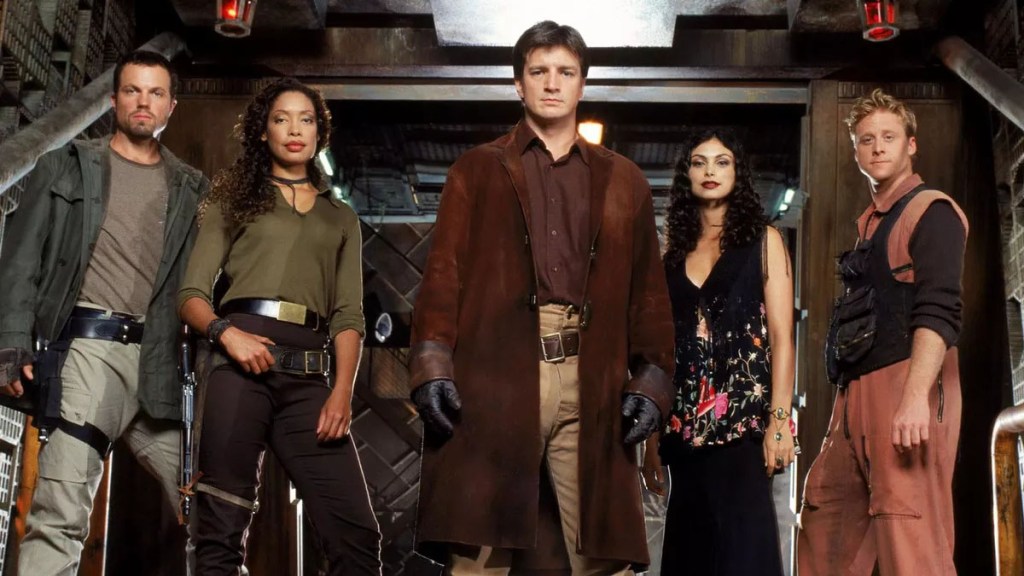
Sci-fi may entreat us to look forward, and the wild west may bid us to look back, but what both genres really give us is a snapshot of who we are in any given now, whether that’s in our capacity as writers, creators, actors, audiences or just plain old people.
Our visions of the past and of the future are always viewed and filtered through the prism of our present, which allows the wild frontier and the final frontier to become sites of constant renewal, re-interpretation and re-discovery. The feelings of timelessness and wonder inspired by these genres, along with their fluidity and flexibility as story-telling devices, is what has made them such great, and natural, bed-fellows. While the western isn’t as big a draw (forgive me) for audiences as it once was, its themes, heroes, hopes, tropes, ideas, ideals, evils and agonies live on in the realms of sci-fi and fantasy.

